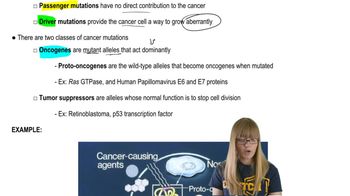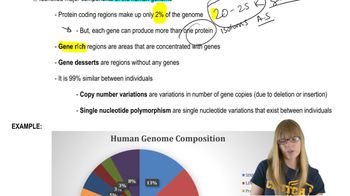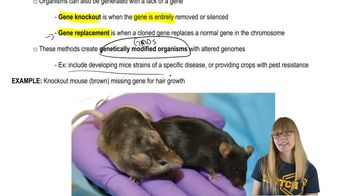Table of contents
- 1. Introduction to Genetics51m
- 2. Mendel's Laws of Inheritance3h 37m
- 3. Extensions to Mendelian Inheritance2h 41m
- 4. Genetic Mapping and Linkage2h 28m
- 5. Genetics of Bacteria and Viruses1h 21m
- 6. Chromosomal Variation1h 48m
- 7. DNA and Chromosome Structure56m
- 8. DNA Replication1h 10m
- 9. Mitosis and Meiosis1h 34m
- 10. Transcription1h 0m
- 11. Translation58m
- 12. Gene Regulation in Prokaryotes1h 19m
- 13. Gene Regulation in Eukaryotes44m
- 14. Genetic Control of Development44m
- 15. Genomes and Genomics1h 50m
- 16. Transposable Elements47m
- 17. Mutation, Repair, and Recombination1h 6m
- 18. Molecular Genetic Tools19m
- 19. Cancer Genetics29m
- 20. Quantitative Genetics1h 26m
- 21. Population Genetics50m
- 22. Evolutionary Genetics29m
15. Genomes and Genomics
Genomics and Human Medicine
Problem 12a
Textbook Question
You have identified a recessive mutation that alters bristle patterning in Drosophila and have used recombinant DNA technology to identify a genomic clone that you believe harbors the gene. How would you demonstrate that your gene is on the genomic clone?
 Verified step by step guidance
Verified step by step guidance1
Step 1: Perform a complementation test by introducing the genomic clone into a Drosophila strain that is homozygous for the recessive mutation. Observe if the wild-type bristle pattern is restored, indicating that the clone contains the functional gene.
Step 2: Conduct a rescue experiment by inserting the genomic clone into a vector suitable for Drosophila transformation and introduce it into mutant flies. Check if the bristle pattern is corrected in the transformed flies.
Step 3: Use Southern blot analysis to confirm the presence of the genomic clone in the transformed flies' DNA, ensuring that the clone has integrated into the genome.
Step 4: Perform a sequence analysis of the genomic clone to identify the gene of interest and compare it with known sequences to confirm its identity.
Step 5: Use RNA in situ hybridization or RT-PCR to verify that the gene on the genomic clone is expressed in tissues where bristle patterning occurs, supporting its role in the phenotype.
Recommended similar problem, with video answer:
 Verified Solution
Verified SolutionThis video solution was recommended by our tutors as helpful for the problem above
Video duration:
3mPlay a video:
Was this helpful?
Key Concepts
Here are the essential concepts you must grasp in order to answer the question correctly.
Recessive Mutation
A recessive mutation is a genetic alteration that only manifests phenotypically when an individual has two copies of the mutated allele. In the context of Drosophila, this means that the altered bristle patterning will only be observed in flies that inherit the recessive allele from both parents. Understanding this concept is crucial for determining how the mutation affects the phenotype and for designing experiments to identify the responsible gene.
Recommended video:
Guided course

Cancer Mutations
Recombinant DNA Technology
Recombinant DNA technology involves combining DNA from different sources to study specific genes or genetic functions. This technique allows researchers to isolate and clone genes of interest, such as the one responsible for the bristle patterning mutation in Drosophila. By using this technology, you can create genomic clones that may contain the gene, facilitating further analysis and experimentation to confirm its role in the observed phenotype.
Recommended video:
Guided course

Recombination after Single Strand Breaks
Genomic Cloning and Gene Mapping
Genomic cloning is the process of isolating and amplifying a specific segment of DNA, which can then be analyzed to determine its function. Gene mapping involves identifying the location of a gene within a genome, often using techniques like PCR, sequencing, or hybridization. To demonstrate that the gene is on the genomic clone, you would typically perform experiments such as complementation tests or gene expression analysis to show that the cloned DNA can restore the wild-type phenotype in the presence of the recessive mutation.
Recommended video:
Guided course

Mapping Genes

 6:51m
6:51mWatch next
Master Human Genome Composition with a bite sized video explanation from Kylia Goodner
Start learningRelated Videos
Related Practice



